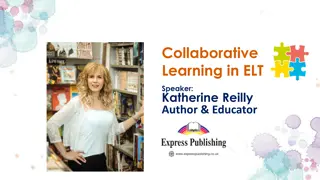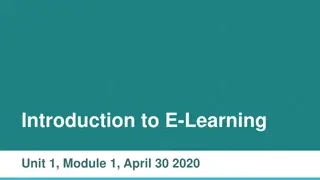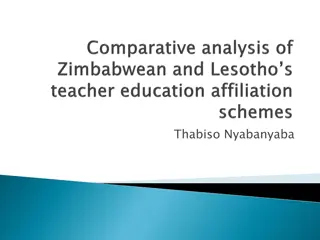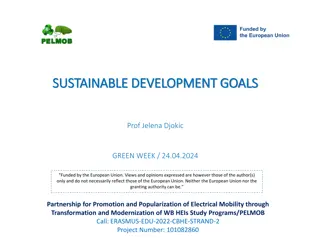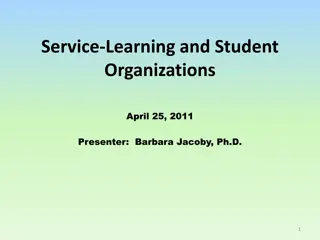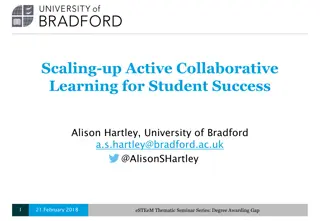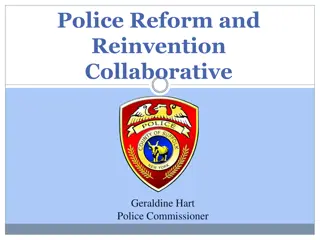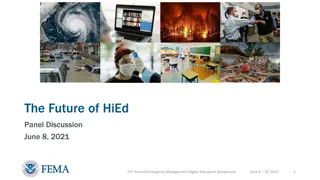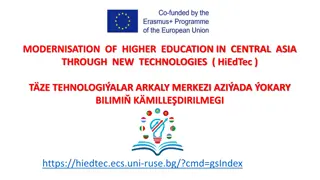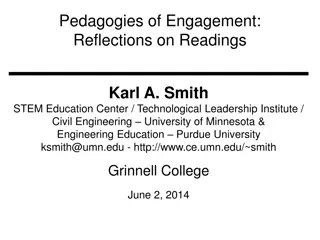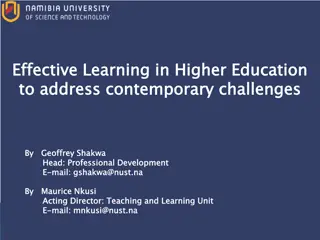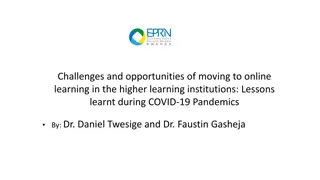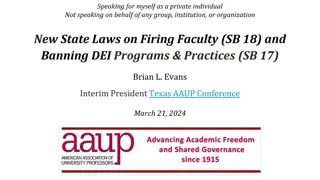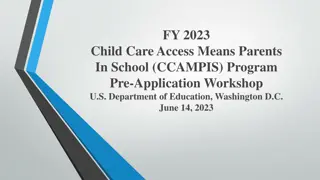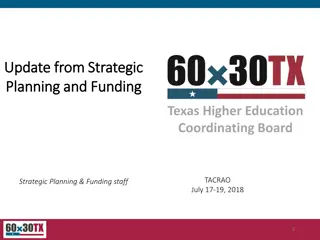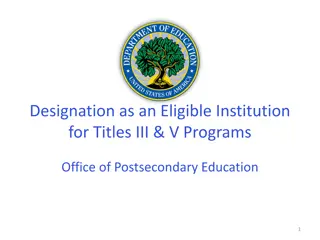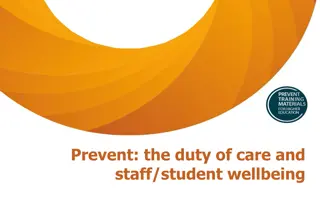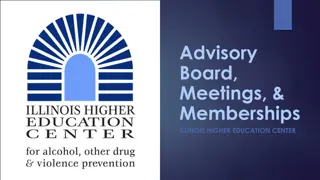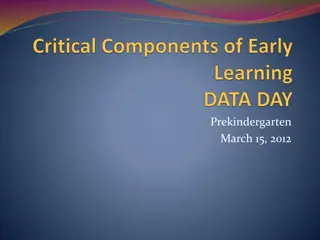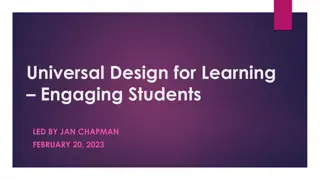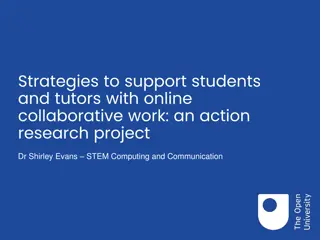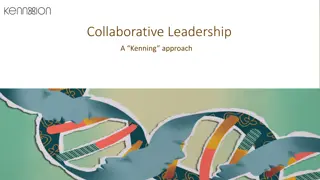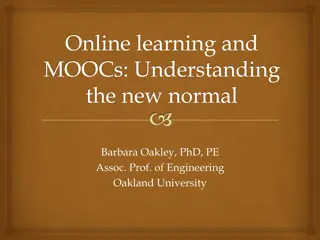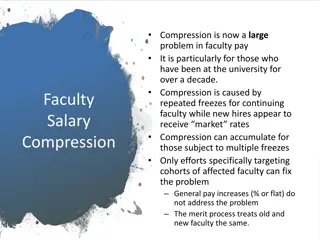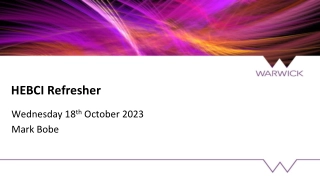The Impact of Collaborative Learning Strategies in Higher Education
Explore the implementation of collaborative learning in college classrooms through the experiences and insights shared by a group of educators from Creighton University. The session aims to enhance critical thinking skills, examine student perceptions, and provide practical recommendations for integrating collaborative learning. Discover the key elements of the agenda and gain insights into the university's diverse undergraduate divisions and student body profiles.
Download Presentation

Please find below an Image/Link to download the presentation.
The content on the website is provided AS IS for your information and personal use only. It may not be sold, licensed, or shared on other websites without obtaining consent from the author. Download presentation by click this link. If you encounter any issues during the download, it is possible that the publisher has removed the file from their server.
E N D
Presentation Transcript
More than Just a Game: The Ups and Downs of Implementing Collaborative Learning Anne Schoening, PhD, RN, CNE Susan Selde, MS Joyce Tow, PhD(c), APRN-WHNP-BC, RNC-OB Joely Goodman, MSN, RN Cindy Selig DNP, APRN, RNC-OB, CPLC Amy Cosimano, EdD, RN Amy Yager DNP, APRN, FNP-C Kim Galt, PharmD, PhD, FASHP, FNAP Chris Wichman, PhD (statistician)
Objectives At the end of the session, participants will be able to: Describe how collaborative learning strategies can be integrated into the college classroom. Discuss the potential impact of collaborative learning on critical thinking skills. Analyze faculty recommendations for implementing collaborative learning based on student perceptions.
Agenda Creighton University Overview (5 minutes) Ice Breaker (10 minutes) Presentation(15 minutes) Group Activity (15 minutes) Study Results (15 minutes) Group Evaluation/Feedback (5 minutes) Think-Pair-Share (5 minutes) Audience questions (5 minutes)
Creighton University National Liberal Arts University Private, Catholic, Jesuit 8,019 total students 4,076 undergraduates 3,943 graduate and professional students
Three Undergraduate Divisions College of Arts & Sciences College of Business College of Nursing
Undergrad Student Body Middle 50% ACT24-30SAT 1120-1350 GPA 3.5-4.0 24% ranked in the top 5% of their high school class 40% ranked in the top 10% of their high school class
Professional and Graduate Schools Graduate Dentistry Law Medicine Pharmacy Physical Therapy Occupational Therapy
Accelerated Nursing Program (ANC) 12-month BSN second degree program 3 semesters 18-20 credit hours/semester Average age: 26 years Non-traditional
Traditional: Tuition for 2014-2015 academic year: $33,796 Combined with fees, room, and board: $49,969 Accelerated 2014-2015: $47,976
Ice Breaker On the index card please write: Your name University and Discipline One or two things you do well A place you want to visit A task you want to achieve An activity you like to do
Ice Breaker Draw a card Role assignment: Recorder: -records points for team Folder Monitor: -collects cards Discussion Leader: -reads cards Spokesperson: -report team score
Ice Breaker - Points for Correctly Identifying Group Members First attempt = 4 points Second attempt = 3 points Third attempt = 2 points Fourth attempt = 1 point
What is collaborative learning? Working with others to achieve shared learning goals (Barkley, Cross & Major, 2005, p. 4) Intentional design Co-labor; shared workload Tasks should relate to learning objectives
Pedagogical Rationale Cognitive Learning Theory Students actively engaged in learning Making connections -rehearsing, restructuring, scaffolding (Johnson, Johnson, & Smith, 1998) Behavioral Learning Theory
Pedagogical Rationale Social Interdependence Theory (Johnson, Johnson, & Smith, 1998) Collaboration on a common goal Promotive interaction vs. competitive interaction
Research Group learning contributes to: Content mastery Critical thinking Problem solving Interpersonal skill development (Johnson, Johnson, & Smith, 1998)
To teach is to learn twice. Joseph Joubert 1754-1824
Who benefits? Underprepared students Well-prepared students Female students Minority students International students (Slavin, 1996; Cabrera, 1998 as cited in Barkley, Cross, & Major, 2005)
The process Orient students Form groups Structure the learning task Facilitate collaboration Evaluate (Barkley, Cross, & Major, 2005)
Orienting students Icebreakers Procedures: Syllabus review Group ground rules Explain rationale Learning contracts
Forming groups Informal Formal: Based on major/interest Ability Optimal size: 3-4 Assign roles: Recorder Reporter Discussion leader/facilitator Folder monitor
Structuring the task What is your purpose? Discussion Problem solving Writing
Facilitating collaboration You have a new role!
Evaluation Group self-evaluation Collaborative Quizzes Collaborative Testing Student Surveys
Our Study Unfolding PBL case study Formal groups over one month Low risk obstetric content in undergraduate nursing course Playing Card Method (Hilton, Millis, & Kopera-Frye, 2006)
Problem-Based Learning (PBL) Students presented with a real world problem Students responsible for solving the problem Students collaborate Active learning Teacher as facilitator (Savery, 2006)
Meet your patient Laura Smith is a 28 year-old G1P0 who presents to the antepartum clinic stating that she had a positive home pregnancy test 5 days ago. Laura is married to Tom, who accompanies her to the clinic. Laura is a first-grade teacher and spends most of the day on her feet. She is excited about this pregnancy, which was planned. Laura states she is experiencing occasional nausea and vomiting, breast tenderness, and fatigue. The first day of her LMP was August 20
Activity Role Assignment: Recorder: Folder Monitor: Discussion Leader: Spokesperson: Scenario Collaboration: Answer your group s question (5 minutes) Groups Present (10 minutes)
Multiple Choice Question The person most at fault in the above scenario is a.Shari, she asked a friend to act unethically b.Jane, she did not need to agree to this misrepresentation of information c.The instructor, after all, Shari was intimidated and needed to falsify information d.Shari and Jane are equally at fault
Methodology Full Implementation Pilot ANC Group 3 Traditional Group 2 (Fall 2012) ANC Group 1 Collaboration approach developed In class discussion Collaboration In class discussion (Fall 2011) Lecture Collaboration Wiki on-line ANC Group 2 Pilot (Fall 2010) (Spring 2012) Traditional Students Comparison
Three phases Phase 1 Pilot: Fall, 2010 n=103 Traditional students Phase 2 Comparison 2011-2012 Accelerated nursing students Fall: Lecture n= 57 Spring: Collaborative learning n= 33 Phase 3 Full Implementation: Fall, 2012 Traditional: n=90 Accelerated: n=63
Univariate Analysis (ANOVA) Type 3 Tests of Fixed Effects Effect Age Semester Gender Degree Enter GPA Num DF 1 2 1 2 1 Den DF 151 150 151 150 150 F Value 0.01 3.58 5.75 1.79 5.18 Pr > F 0.9136 0.0304 0.0177 0.1699 0.0243 (Exam run against each explanatory variable separately)
Best Model Type 3 Tests of Fixed Effects Num DF Den DF 2 149 1 149 Effect Semester Gender F Value 3.58 5.74 Pr > F 0.0302 0.0179 Least Squares Means Standard Error 1.1005 1.0175 1.3727 0.6173 1.5312 Effect SE GE N Estimate DF t Value Pr > |t| M F11 F12 S12 SEM SEM SEM GEN GEN 87.1261 84.3982 83.5567 86.9762 83.0778 149 149 149 149 149 79.17 82.95 60.87 140.90 54.26 <.0001 <.0001 <.0001 <.0001 <.0001 F M (Not containing extraneous factors)
Comparing Exam Sections Semester Student type Overall Goodness of Fit Chisq Fisher Newborn Nutrition Antepartum 0.1778 0.1590 Newborn 0.3902 0.3956 Intrapartum 0.7594 0.7713 Postpartum 0.8535 0.8949 Chisq Fisher Antepartum 0.3898 0.4671 Intrapartum 0.9087 1.0000 Postpartum 0.6201 0.8154 Newborn 0.8057 0.8511 Newborn Nutrition 0.2629 0.2499 0.5158 0.5903
Performance by Teaching Method NUR290 Method Lecture Collaborative Collaborative + Wiki Frequency B 14 2 Percentage B A 29 12 B+ 6 4 C+ 3 4 C 1 9 D 4 2 A B+ C+ C D 50.88 10.53 24.56 5.26 36.36 12.12 6.06 12.12 27.27 6.06 1.75 7.02 17 16 9 8 7 6 26.98 25.4 14.29 12.7 11.11 9.52
Performance by Teaching Method NUR290 Method Pass Lecture Collaborative Collaborative + Wiki Frequency Percentage Pass 92.98 7.02 93.93 6.06 Fail 4 2 Fail 53 31 57 6 90.48 9.52
Student Perceptions (5-point Likert Scale) Q1: Working in learning teams enhanced my learning. Q2: Working in learning teams enhanced my ability to explain nursing rationale. Q3: I felt that the collaborative quiz helped to prepare me for the unit exam. Q4: Working in a team helped me enhance my conflict resolution skills when the group did not initially agree. Q5: Being assigned to a team helped me to work with individuals that I would not normally choose to work with.
Student Perceptions Traditional Students: Collaborative vs Collaborative + Wiki Estimated Odds Ratio 95% Lower Bound 95% Upper Bound p-value Question Score Test* 1 0.0609 3.812 2.013 7.219 <0.001 2 0.3261 4.101 2.153 7.814 <0.001 3 0.7842 1.666 0.891 3.115 0.1101 4 0.6487 3.522 1.853 6.696 0.0001 5 0.3697 1.429 0.783 2.610 0.2449 *Score Test for the Proportional Odds Assumption
Student Perceptions Accelerated Students: Collaborative vs Collaborative + Wiki Question Score Test* Estimated 95% Lower Bound 95% Upper Bound p-value Odds Ratio 1 0.6707 45.840 11.122 188.923 <.0001 2 0.0227 11.48 3.54 37.17 <.0001** 3 0.7112 9.089 3.311 24.945 <.0001 4 0.5723 19.696 5.709 67.945 <.0001 5 0.0463 3.25 1.11 9.54 0.0356** *Score Test for the Proportional Odds Assumption. **Data was dichotomized into categories favored (Agree and Strongly Agree) and Not Favored (Neutral, Disagree, and Strongly Disagree); p-value is based on Fisher s Exact Test.
Qualitative Data The best thing about working with learning teams during this unit was: The worst thing about working with learning teams during this unit was:
Collaborative Learning Qualitative Data Themes Content Content Delivery Content Mastery Collaborative Learning
Content Explains the value, impact and accuracy of the content delivered to students.
Content Sub-themes Exam Content - Content worthy of examination purposes. Information Overload Excessive amount to material presented to class. Accuracy of Information- The correctness of information presented
Content Delivery Incorporates a variety of methods and management of methods used to transmit (deliver) the curriculum material (content)
Content Delivery Sub-themes Logistics Includes instructor management of time, use of PowerPoint slides, acoustics, resources, facilitation and structure of lesson Lecture- Comparing collaborative learning with traditional lecture* Active Learning- A technique used whereby students are doing hands -on activities. Students talk/discuss in groups and group presents to class. Wiki- A technique used whereby students post information to an online site. + for lecture is for collaborative learning
Content Mastery Refers to student ability to learn independently, understand and apply material and critically think
Content Mastery Sub-themes Independent Learning The ability to self regulate learning. Learning The effect of this study s teaching strategies on student understanding. Critical Thinking Problem solving skills
Collaborative Learning Includes social interdependence, different perspectives and interpersonal skills
Collaborative Learning: Sub-themes Social Interdependence A group with a shared goal, work together for the overall success of the group. (Johnson, 1999) Different Perspectives Variety of viewpoints regarding the same concept Interpersonal Skills Skills needed to build relationships with others


